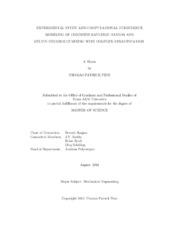| dc.contributor.advisor | Ranjan, Devesh | |
| dc.creator | Finn, Thomas Patrick | |
| dc.date.accessioned | 2015-02-05T17:23:58Z | |
| dc.date.available | 2016-08-01T05:30:12Z | |
| dc.date.created | 2014-08 | |
| dc.date.issued | 2014-06-24 | |
| dc.date.submitted | August 2014 | |
| dc.identifier.uri | https://hdl.handle.net/1969.1/153312 | |
| dc.description.abstract | An experimental study of the combined Rayleigh-Taylor instability (RTI) and Kelvin-Helmholtz instability (KHI) is presented at three different Atwood numbers (0.05, 0.971, 0.147) and multiple velocity ratios to examine the morphological development of the flow field. The Atwood number is the ratio of the difference between the densities of the heavy and light streams to their sum. These experiments were performed using the multilayer gas tunnel facility at Texas A&M University. The
tunnel is a convective type system, where gases of different densities flow parallel to one another and are separated by a splitter plate until mixing is allowed downstream in the test section. Three-wire hot-wire probe and particle-image velocimetry (PIV) diagnostic techniques are used to set the velocities in the experiments. Visualization is performed using a high resolution digital camera by injecting fog into one of the streams and collecting scattered light from the illuminated fog particles. Shear effects on the complex stratification are studied. Complex stratification occurs when there is a non-constant density profile in the light fluid mixture, while the constant density profile case is referred to as generic stratification. Transition was found to occur between Richardson numbers of -0.25 and -1.0. Additionally, two different scenarios with and without complex stratification are examined through the mixing layer growth and the non-dimensional growth rate parameter α_(b,s). Complex stratification was found to produce higher mixing layer growth and larger values of α_(b,s) than generic stratification.
The stratification experiments were also simulated using a one-dimensional, two-equation K-ԑ Reynolds-averaged Navier-Stokes (RANS) model in collaboration with Lawrence Livermore National Laboratory (LLNL). The model is implemented in a hydrodynamics code using a third-order weighted essentially non-oscillatory (WENO) or central differencing method for the advection terms, a second-order central differencing method for the gradients in the source, sink, and diffusion terms, and a second-order implicit Crank-Nicolson (CN) method for the time evolution. Simulations are compared to experiments through the mixing layer and non-dimensional growth parameter α_(b,s). The overall trends shown by the simulations were consistent with experimental data. Specific values for growth height and α_(b,s), however, were found to be vastly under predicted. | en |
| dc.format.mimetype | application/pdf | |
| dc.language.iso | en | |
| dc.subject | Rayleigh-Taylor Instability | en |
| dc.subject | Kelvin-Helmholtz Instability | en |
| dc.subject | Complex Stratification | en |
| dc.subject | Reynolds-Averaged Navier-Stokes Model | en |
| dc.subject | Multilayer Gas Tunnel Facility | en |
| dc.title | Experimental Study and Computational Turbulence Modeling of Combined Rayleigh-Taylor and Kelvin-Helmholtz Mixing with Complex Stratification | en |
| dc.type | Thesis | en |
| thesis.degree.department | Mechanical Engineering | en |
| thesis.degree.discipline | Mechanical Engineering | en |
| thesis.degree.grantor | Texas A & M University | en |
| thesis.degree.name | Master of Science | en |
| thesis.degree.level | Masters | en |
| dc.contributor.committeeMember | Reddy, Junuthula N. | |
| dc.contributor.committeeMember | Reed, Helen | |
| dc.contributor.committeeMember | Schilling, Oleg | |
| dc.type.material | text | en |
| dc.date.updated | 2015-02-05T17:23:58Z | |
| local.embargo.terms | 2016-08-01 | |
| local.etdauthor.orcid | 0000-0002-0733-8608 | |


